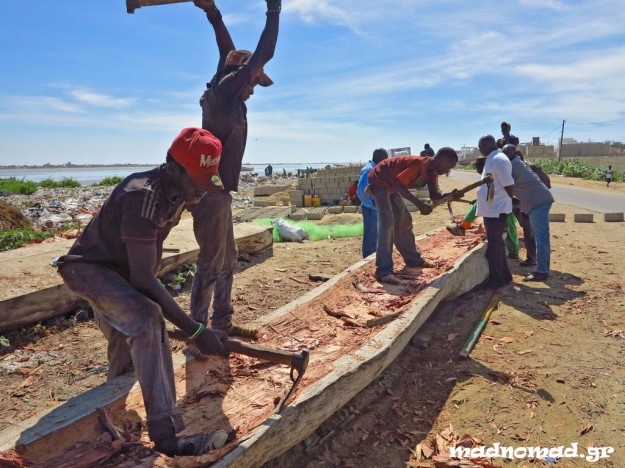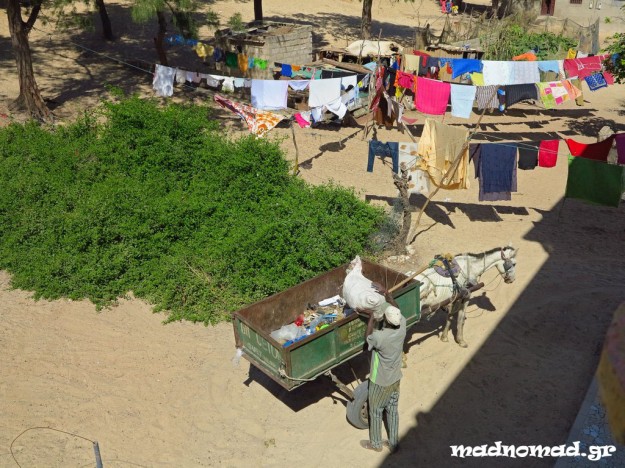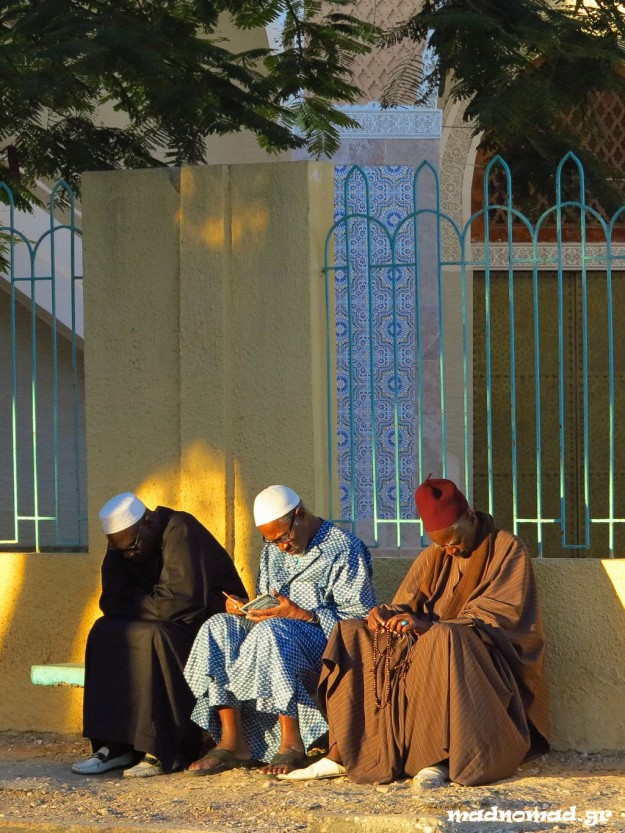Senegal: Sub-Saharan Africa has opened up before us!Σενεγάλη: Η Υποσαχάρια Αφρική ανοίγεται μπροστά μας!
It is well known that the borders between Mauritania and Senegal are guarded by some of the most corrupted officers of all borders in Africa. Travelers are frustrated and are obliged to pay a fortune in bribes. That was the reason we decided to cross the border through Diama, instead of Rosso which has the worst reputation. Unfortunately, we sadly realized that the officers in Diama have copycatted the style of their colleagues in Rosso, with the situation being tragic there as well.
Both on Mauritanian and on Senegal side, they were asking 10 euros for every stamp they were putting on our passports and on the custom office’s documents. We knew how things work before reaching the border, so we were ready to deal with it patiently. On the Mauritanian side we managed to skip bribing. On the Senegalese side, however, a ruthless officer was keeping our papers and would not give them back unless we paid the money he demanded!
From the moment we set foot in Senegal it was obvious that we had reached the Sub-Saharan Africa. The scenery of the desert gave its place to savannah, the locals with the Arabic characteristics were replaced by the black people of West Africa, while the culture that we encounter is much different.
We made our first stop in Saint-Louis, where we were hosted by a French guy, Samuel, and his two Senegalese flatmates, Bouba and Baye. We are really grateful to these guys, as they made as forget all about our nasty experience at the border and took us straight into the essence of the Senegalese culture, just to make us realize that most of the Senegalese who do not wear a uniform are wonderful people, smiling, with great sense of humor and full of energy!
Just a few hours after having arrived in Saint-Louis, we took our motorcycles and went over some friends of these guys. Everybody was gathered in a room. Most of the people there were musicians, so it was not long before they took their guitars and drums and started playing. What a fascinating experience that was! Their music had such an energy… Here “Angie” and “Dust in the wind” were not part of the menu… Not that we don’t like these songs but these people were playing genuine African music and we were surprised to hear our beloved “Tajabone” of the Senegalese Ismaël Lô. The exceptional music of Senegal that you are most likely to listen to is called “mbalax”. It’s a mix of Cuban beat along with African drums! Men, women and children were dancing rapturously! We were struck by how much men and women are being mingled here. This is quite a difference compared to North Africa.
After a couple of hours, women prepared dinner for everyone. They laid a few tablecloths on the floor and brought three big, stainless steel platters. We all sat on the floor around them and ate using our hands. They even brought us some homemade juices to drink. Everything was great! After dinner, we said goodbye to everyone and left, as we were whacked after such a long day…

Just a few hours after having entered Senegal, we found ourselves amongst a cheerful party of musicians!
Saint-Louis was founded in 1659 on an isle of Senegal River and it was the first French settlement in Africa. Grid town planning and European architecture indicate that it is no ordinary African town. The house where we were being hosted was situated on one of the most picturesque spots of the area. It was on the peninsula, south of the town, built literally on the seaside. We spent endless hours gazing at the Atlantic Ocean while in the night we were sleeping with the window open, so that we could hear the soothing sound of the waves, something that we had missed a lot…

The seaside in front of the house where we were being hosted was the view we were enjoying for many hours every day…
It was there where I found out that, quite strangely, the tube of the rear tyre of my motorcycle was punctured. That was very surprising, as I had installed an ultra heavy duty tube, with every modern control and self-programming system! When I took it off, I found out that a crumple had occurred and there was a small puncture there. I went over a local repair shop and witnessed something unbelievable… The workman stitched the puncture with needle and thread! He put on top a soft, sticky rubber and then pressed the tube for five minutes on a custom made press, where he had adjusted one of those old flatirons working with charcoals, the ones that our grannies were using for ironing clothes. The rubber soon melted and became one with the tube. I was very anxious to see if this technique would actually work. Indeed, after so many days the tyre has not lost its air pressure! Repair cost: 3 euros!

Restaurant at Yoff, the independent Muslim quarter of Dakar, where there are no government officials, it is self-administering and crime is unheard.
After 134 days on the road, we arrived in Dakar! I guess we did not windup first, did we? Nevertheless, it seems to me that we did a good time for the Thessaloniki – Dakar route! I remember every magic moment of each day… In the suburbs of the capital we are being hosted by Wilson, a Nigerian guy with a big heart, who has migrated to Senegal and he sells shoes on the streets. He lives in a simple neighbourhood with filthy alleys, in the house of a warm Senegalese family that has adopted us.

With Wilson, the Nigerian guy who is hosting us in the suburbs of Dakar, and his friend whom he calls ”father”.
It was time to take care of our motorcycles. We found two good rear tyres and we welded Christina’s aluminium water tank, which was cracked after so many falls in the vast lands of Sahara. We also made some other small repairs and we are now ready to continue our trip to the south!

The picturesque Gorée Island which for many slaves was the final stop before arriving to the Americas, if they had made it through the hard trip across the ocean…
Τα σύνορα μεταξύ Μαυριτανίας και Σενεγάλης είναι γνωστό πως έχουν τους πιο διεφθαρμένους υπαλλήλους απ’ όλα τα σύνορα της Αφρικής. Οι ταξιδιώτες περνούν ένα Γολγοθά κι αναγκάζονται να ξοδέψουν αρκετά χρήματα σε φιλοδωρήματα. Γι’ αυτό το λόγο προτιμήσαμε να περάσουμε από τα σύνορα στη Diama, αντί γι’ αυτά στο Rosso, που έχουν τη χειρότερη φήμη. Δυστυχώς, διαπιστώσαμε ότι οι υπάλληλοι στη Diama έχουν μάθει πολλά κόλπα από τους συναδέλφους τους στο Rosso, οπότε η κατάσταση είναι κι εκεί τραγική.
Τόσο στη μαυριτανική, όσο και στη σενεγαλέζικη πλευρά, μας ζητούσαν 10 ευρώ ανά άτομο για κάθε σφραγίδα που έβαζαν, μια στο διαβατήριο και μια στα έγγραφα για το τελωνείο. Ξέραμε τι θα συναντήσουμε, οπότε είχαμε οπλιστεί με υπομονή πριν φτάσουμε στα σύνορα. Στη μαυριτανική πλευρά τα γλιτώσαμε τα φιλοδωρήματα. Στη σενεγαλέζικη, όμως, ο αδίστακτος αστυνομικός κρατούσε τα έγγραφά μας και δε μας τα ‘δινε πίσω αν δεν του δίναμε τα χρήματα που ήθελε!
Από το πρώτο μας βήμα στη Σενεγάλη ήταν φανερό πως μπήκαμε πια στην Υποσαχάρια Αφρική. Το ερημικό τοπίο έδωσε τη θέση του στη σαβάνα, οι ιθαγενείς με την αραβική επιρροή αντικαταστάθηκαν από τους μαύρους της Δυτικής Αφρικής, ενώ η κουλτούρα που συναντούμε είναι αρκετά διαφορετική.
Πρώτος μας σταθμός ήταν το Saint-Louis, όπου μας φιλοξένησε ο Γάλλος Σαμουήλ κι οι δυο Σενεγαλέζοι συγκάτοικοί του, ο Μπούμπα κι ο Μπάι. Τους χρωστάμε ευγνωμοσύνη, γιατί τα παιδιά μας έκαναν να ξεχάσουμε τη δυσάρεστη εμπειρία των συνόρων και μας βούτηξαν κατευθείαν στα βαθιά της Σενεγάλης, για να διαπιστώσουμε πως οι περισσότεροι Σενεγαλέζοι που δε φορούν στολή είναι υπέροχοι άνθρωποι, χαμογελαστοί, με χιούμορ και πολύ ενέργεια!
Μόλις λίγες ώρες αφού φτάσαμε στο Saint-Louis, πήραμε τις μοτοσυκλέτες και πήγαμε στο σπίτι κάποιων φίλων των παιδιών. Ήταν όλοι μαζεμένοι σ’ ένα δωμάτιο. Οι περισσότεροι ήταν μουσικοί, οπότε χωρίς να χάσουν χρόνο πήραν την κιθάρα και τα τύμπανά τους κι άρχισαν να παίζουν. Ήταν καταπληκτική εμπειρία! Είχε πολύ ενέργεια η μουσική τους. Εδώ δεν ακούσαμε ούτε το “Να μ’ αγαπάς” ούτε το “Dust in the wind”… Δε λέω, ωραία τραγούδια κι αυτά, αλλά οι άνθρωποι έπαιζαν αφρικανική μουσική και μας εξέπληξαν όταν ακούσαμε το αγαπημένο μας “Tajabone” του Σενεγαλέζου Ismael Lô. Η περίφημη μουσική της Σενεγάλης, που συνήθως ακούγεται, είναι η mbalax, μια μίξη κουβανέζικου ρυθμού κι αφρικανικών κρουστών! Άντρες, γυναίκες και παιδιά χόρευαν εκστασιασμένοι! Μας έκανε εντύπωση το πόσο πολύ αναμιγνύονται εδώ οι γυναίκες με τους άντρες. Αυτή είναι μια εμφανής διαφορά με τη Βόρεια Αφρική.
Μετά από 2-3 ώρες, οι γυναίκες ετοίμασαν φαγητό για όλους. Έστρωσαν μερικά τραπεζομάντιλα στο πάτωμα κι έφεραν τρεις μεγάλες, ανοξείδωτες πιατέλες. Κάτσαμε όλοι γύρω τους και φάγαμε με τα χέρια. Μας έφεραν και σπιτικούς χυμούς. Ήταν όλα τέλεια! Μετά το γεύμα, τους χαιρετήσαμε όλους έναν-έναν και φύγαμε, αφού ήμασταν ψόφιοι μετά από μια τόσο γεμάτη μέρα…

Μόλις λίγες ώρες αφού μπήκαμε στη Σενεγάλη, βρεθήκαμε ανάμεσα σε μια παρέα μουσικών γεμάτη ζωντάνια!
Το Saint-Louis ιδρύθηκε το 1659 σ’ ένα νησάκι μέσα στο Σενεγάλη Ποταμό κι ήταν η πρώτη γαλλική αποικία στην Αφρική. Η δομημένη ρυμοτόμηση κι η ευρωπαϊκή αρχιτεκτονική δείχνουν αμέσως πως δεν πρόκειται για μια συνηθισμένη αφρικανική πόλη. Το σπίτι όπου μας φιλοξενούσαν βρίσκεται σ’ ένα από τα πιο γραφικά σημεία της περιοχής. Είναι στη χερσόνησο που εκτείνεται νότια της πόλης κι είναι χτισμένο κυριολεκτικά πάνω στην αμμουδιά. Περάσαμε αμέτρητες ώρες στο μπαλκόνι χαζεύοντας τον Ατλαντικό, ενώ το βράδυ κοιμόμασταν με ανοιχτό το παράθυρο και μας νανούριζε η όμορφη μουσική των κυμάτων, που μας είχε λείψει…

Η παραλία μπροστά στο σπίτι όπου φιλοξενούμασταν ήταν η εικόνα που απολαμβάναμε γι’ ατέλειωτες ώρες…
Εκεί διαπίστωσα πως, περιέργως, είχε τρυπήσει η πισινή σαμπρέλα της μοτοσυκλέτας μου. Μου έκανε εντύπωση, γιατί είχα βάλει ultra heavy duty σαμπρέλα με όλα τα σύγχρονα συστήματα ελέγχου και αυτοπρογραμματισμού! Όταν την έβγαλα, διαπίστωσα πως είχε τσαλακωθεί σε κάποιο σημείο και πάνω στο τσαλάκωμα έκανε ένα μικρό σκίσιμο. Πήγα σ’ ένα τοπικό βουλκανιζατέρ κι είδα κάτι απίστευτο… Ο μάστορας έραψε το σκίσιμο με κλωστή και βελόνα! Από πάνω έβαλε μια μαλακή, κολλώδη γόμα κι ύστερα πάτησε τη σαμπρέλα για πέντε λεπτά σε μια αυτοσχέδια πρέσα, όπου είχε προσαρμόσει ένα από ‘κείνα τα παλιά σίδερα που λειτουργούν με κάρβουνο και τα χρησιμοποιούσαν οι γιαγιάδες μας για το σιδέρωμα των ρούχων. Η γόμα έλιωσε κι έγινε ένα με τη σαμπρέλα. Ανυπομονούσα να δω αν θα λειτουργήσει η τεχνική αυτή. Κι όμως, μετά από τόσες μέρες το λάστιχο δεν έχει χάσει καθόλου αέρα! Κόστος επισκευής: 3 ευρώ!

Εστιατόριο στην ανεξάρτητη, μουσουλμανική συνοικία του Dakar, το Yoff, που δεν έχει δημόσιους υπαλλήλους, είναι αυτοδιοικούμενο και δε γνωρίζει εγκληματικότητα.
Μετά από 134 μέρες στο δρόμο, ήρθε η στιγμή που φτάσαμε στο Dakar! Μάλλον δεν τερματίσαμε πρώτοι, ε; Πάντως εμένα μια χαρά χρόνος μου ακούγεται για το Θεσσαλονίκη – Dakar! Θυμάμαι τη μαγεία κάθε μιας μέρας… Στα προάστια της πρωτεύουσας μας φιλοξενεί ο Wilson, ένας μεγαλόκαρδος Νιγηριανός, που έχει μεταναστεύσει στη Σενεγάλη και πουλά παπούτσια στους δρόμους. Μένει σε μια φτωχογειτονιά ανάμεσα σε χωματόδρομους γεμάτους βρομόνερα και σκουπίδια, στο σπίτι μιας ζεστής σενεγαλέζικης οικογένειας που μας έχει υιοθετήσει.

Με το Wilson, το Νιγηριανό που μας φιλοξενεί στα προάστια του Dakar, και το φίλο του που αποκαλεί “πατέρα”.
Εδώ ήρθε η ώρα να περιποιηθούμε λίγο τις μοτοσυκλέτες μας. Βρήκαμε δυο καλά ελαστικά για τις πισινές ρόδες, κολλήσαμε την αλουμινένια δεξαμενή νερού της Χριστίνας, που είχε τρυπήσει και σπάσει από τις πολλές πτώσεις στα βάθη της Σαχάρας, κάναμε και μερικές άλλες μικροεπισκευές κι είμαστε έτοιμοι για τη συνέχεια του ταξιδιού προς το νότο!

Το γραφικό νησάκι Gorée, που γι’ αρκετούς σκλάβους ήταν ο τελευταίος σταθμός πριν φτάσουν στην Αμερική, αν επιβίωναν από το δύσκολο ταξίδι στον ωκεανό…


















